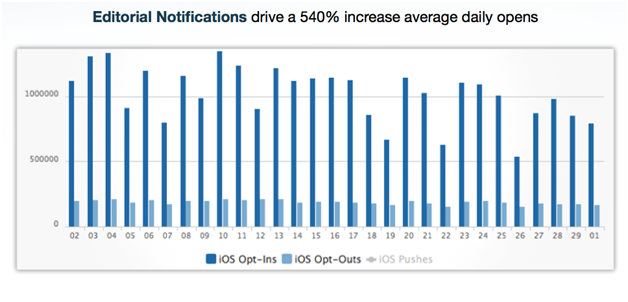Random Apps of Kindness: Using mobile for nonprofit and cause-based marketing
According to Web.com, 84% of small and medium businesses saw an increase in business activity due to their mobile marketing efforts.
This got me thinking … how could mobile marketing help another segment that, much like SMBs, often has limited budgets and time to invest in new marketing tactics – non-profit and cause-based marketers.
So, I asked a few experts in the industry, and they shared a few basic considerations to help you with your mobile marketing efforts …
Consideration #1: Determine if you need a mobile app
Apps have gotten a lot of buzz lately, but they are not the only way to reach a mobile audience.
“Building a mobile app, a good one at least, isn’t cheap,” said Amy Sample Ward, Digital Advisor, Good360.
You might want to start by optimizing your website and email marketing for mobile first.
“Be sure to update form pages for signing up or donating so that people aren’t turned off when they can’t even make out the fields and complete the page,” Amy said.
Once you’ve optimized your current presence for a mobile audience, how can you decide if an app is a logical next step?
“See if mobile views and navigation, opens and clickthroughs on emails, etc. go up as you mobile-ize those areas of content,” Amy remarked.
“The second indicator is the unique content or service an app would provide,” she added. “Unless you have information or data that people will want to access regularly and will actually help them in their day-to-day life, an app probably isn’t a fit.”
“For example, if you are an organization working on clean water access and conservation, an app that shares facts about water is not interesting, nor is it helpful. An app that helps people geo-locate and navigate to places where they can refill their water bottle for free is very helpful and reinforces an organization’s mission.”
Consideration #2: If you do create a mobile app, know what to push
When I was younger, I had a pager at one point. It made me feel very cool … until I started getting paged. Only then did I realize, when I was out and about, I really didn’t want to have to track down a pay phone to call someone. After all, I was otherwise engaged.
Obviously technology has significantly improved since then, but when people are mobile, what type of messages really matter to them? For what would they interrupt a walk on the beach, a trip to the market, or simply a movie at home with their family?
The messages that mobile apps send to your phone are known as push notifications. Like any marketing message, those push notifications can be filled with real value or annoying spam. And, you have the added challenge that, unlike a print or banner ad, your audience is likely engaged in something totally unrelated to the message they are about to receive.
So what should you push? One thing Corey Gault, Director of Communications, Urban Airship, recommends for nonprofits is sending notifications for breaking news and events.
Newsworthy information seems to resonate with mobile users. For example, Corey shared these analytics, showing a lift in engagement that push delivered for a news app:
Consideration #3: Either way, consider ways to engage a mobile audience with collateral
So you’ve optimized your website and email for mobile. You’ve built your mobile app (or found that it wasn’t appropriate for your organization).
Those are mobile marketing tactics that reside in the smartphone itself. What about the environment (remember, these people are mobile, they’re not necessarily sitting at desks all day) that your potential customers are in?
“[Leverage] existing collateral (print, digital) to interact with people at their point of interest, the very moment they are compelled to engage in some sort of dialogue,” suggests T. Bradley M. Goad, Managing Director – Corporate Development & Operations, Mobile Tag.
“Using some form of tag and call-to-action, which currently is exemplified by the use of barcodes [and] QR codes, enables this response and dialogue by quickly and conveniently connecting the interested consumer to the cause marketer’s message. Typically, this means connecting to some Web-based content.”
Bradley provided some examples from a local charity event in Chattanooga, a flyer and a placement in a newspaper …
Here is Bradley’s advice for using tags:
- Employ a clear call-to-action
- Communicate a clear and compelling message
- Ensure a good experience
“For example, cause-related mobile campaigns that we have worked on have used Scan-to-Win devices where the audience has a clear incentive to respond – they could win something or they received a discount for something if they made a contribution – and these have been successful,” Bradley said. “It also presents great opportunities for causes to co-market with sponsors.”
Related Resources:
7 Ways Brands Can Get Push Notifications Right (by Brent Hieggelke, CMO, Urban Airship on Mashable)
Friday Food for Thought: Watching the Game Film (for Nonprofits) (via Amy Sample Ward)
Mobile Marketing: Juniper Networks’ QR code event strategy leads to paperless conference
Mobile Email Marketing: 53% higher clickthrough rate for mobile-optimized newsletter
Video with Frank Kelcz of MobileTag discussing innovative use of tags at Paris bus stops
Categories: Non Profit Fundraising apps, mobile marketing, nonprofit marketing, nonprofit organizations













Great post, Daniel! I totally agree with these 3 topics as major considerations for using mobile. For those interested, Mozilla’s Ignite Challenge is a $500,000 initiative to engage communities and techies in the development of “apps from the future” using next generation (1 Gigabit speed) Internet. We have a free webinar next week to tell nonprofits more about it and how they can participate: http://www.nten.org/events/webinar/2012/07/16/mozilla-ignite-challenge